Samsung Galaxy Note 2 Review (T-Mobile) - The Phablet Returns
by Brian Klug on October 24, 2012 9:00 AM ESTThe original generation Galaxy Note I played with was an AT&T model, and as a result was based around the same platform (I call a platform the combination of SoC and baseband) as the Skyrocket, which was AT&T’s SGS2 with LTE. That platform was Qualcomm’s Fusion 2 chipset, the very popular combination of a APQ8060 SoC (45nm dual core Scorpion at 1.5 GHz with Adreno 220 graphics) and MDM9x00 for baseband (Qualcomm’s 45nm first generation multimode LTE solution). The US-bound Galaxy S 3 variants were built around the successor of that platform, which was Qualcomm’s MSM8960 SoC (28nm dual core Krait at 1.5 GHz with Adreno 225 graphics and an onboard 2nd gen LTE baseband). The result was quick time to market with the latest and greatest silicon, improvements to performance, onboard LTE without two modems, and lower power consumption.

The Galaxy Note 2 does something different, and finally brings Samsung’s Exynos line of SoCs into devices bound for the USA where air interfaces are a combination of LTE, WCDMA, and CDMA2000. It’s clear that the Note 2 was on a different development cycle, and this time the standalone 28nm LTE baseband I’ve been talking about forever was available for use in the Galaxy Note 2, that part is MDM9x15, same as what’s in the iPhone 5, Optimus G, One X+, and a bunch of other upcoming handsets. If you haven’t read our other reviews where I’ve talked about this, the reason is that MDM9x15 is now natively voice enabled (MDM9x00 was not unless you ran with a Fusion platform), smaller, and lower power than its predecessor. The result is that there’s finally a multimode FDD-LTE, TDD-LTE, WCDMA (up to DC-HSPA+), EVDO (up to EVDO Rev.B) and TD-SCDMA baseband out there which doesn’t require going with a two chip solution. I could go on for pages about how this is primarily an engineering decision at this point, but the availability of MDM9x15 is why we see OEMs starting to finally ship handsets based around SoCs other than Qualcomm’s and also include LTE at the same time.
Anyhow, for a lot of people this will be the first time experiencing Samsung’s own current Exynos 4 flagship, Exynos 4412, which is of course quad core ARM Cortex A9s at a maximum of 1.6 GHz alongside ARM Mali–400MP4 built on Samsung’s 32nm HK-MG process. To the best of my knowledge, the Note 2 continues to use a 2x32 bit LPDDR2 memory interface, same as the international Galaxy S 3, though PCDDR3 is also a choice for Exynos 4412.
I’ve put together a table with specifications of the Note 2 and some other recent devices for comparison.
| Physical Comparison | ||||
| Apple iPhone 5 | Samsung Galaxy S 3 (USA) | Samsung Galaxy Note (USA) | Samsung Galaxy Note 2 | |
| Height | 123.8 mm (4.87") | 136.6 mm (5.38" ) | 146.8 mm | 151.1 mm |
| Width | 58.6 mm (2.31") | 70.6 mm (2.78") | 82.9 mm | 80.5 mm |
| Depth | 7.6 mm (0.30") | 8.6 mm (0.34") | 9.7 mm | 9.4 mm |
| Weight | 112 g (3.95 oz) | 133g (4.7 oz) | 178 g | 180 g |
| CPU | 1.3 GHz Apple A6 (Dual Core Apple Swift) | 1.5 GHz MSM8960 (Dual Core Krait) | 1.5 GHz APQ8060 (Dual Core Scorpion) | 1.6 GHz Samsung Exynos 4412 (Quad Core Cortex A9) |
| GPU | PowerVR SGX 543MP3 | Adreno 225 | Adreno 220 | Mali-400MP4 |
| RAM | 1 GB LPDDR2 | 2 GB LPDDR2 | 1 GB LPDDR2 | 2 GB LPDDR2 |
| NAND | 16, 32, or 64 GB integrated | 16/32 GB NAND with up to 64 GB microSDXC | 16 GB NAND with up to 32 GB microSD | 16/32/64 GB NAND (?) with up to 64 GB microSDXC |
| Camera | 8 MP with LED Flash + 1.2MP front facing | 8 MP with LED Flash + 1.9 MP front facing | 8 MP with LED Flash + 2 MP front facing | 8 MP with LED Flash + 1.9 MP front facing |
| Screen | 4" 1136 x 960 LED backlit LCD | 4.8" 1280x720 HD SAMOLED | 5.3" 1280 x 800 HD SAMOLED | 5.5" 1280 x 720 HD SAMOLED |
| Battery | Internal 5.45 Whr | Removable 7.98 Whr | Removable 9.25 Whr | Removable 11.78 Whr |
The Galaxy Note 2 also is one of the first handsets on the market other than Nexus devices to ship running Android 4.1. This puts it at a definite advantage in some tests as we’ll show in a moment, both due to improvements from project butter and what appear to be even newer Mali–400 drivers. I pulled the Note 1 out of my drawer and updated it to Android 4.0.1 and ran all the same tests again.
First up are some of the usual JavaScript performance tests which are run in the stock browser. Anand added a few in, and personally I think we’ve got almost an abundance of JavaScript performance emphasis right now. Again this is strongly influenced by the V8 JIT (Just In Time Compilation) library bundled with the stock browser on Android. OEMs spend a lot of time here optimizing V8 to the nuances of their particular architecture which can make a substantial difference in scores.
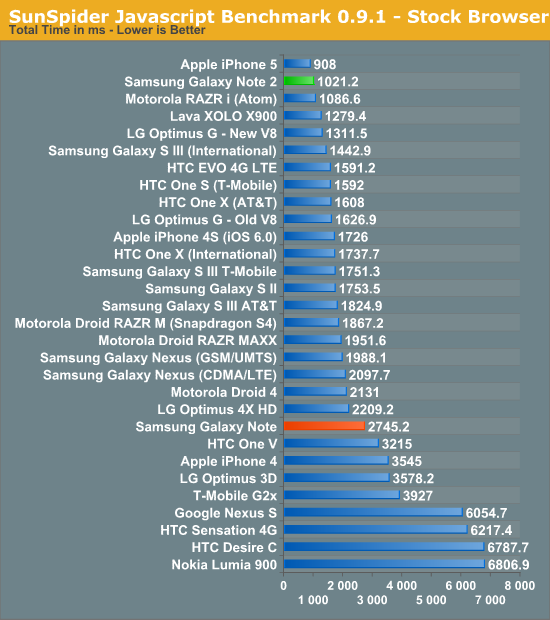

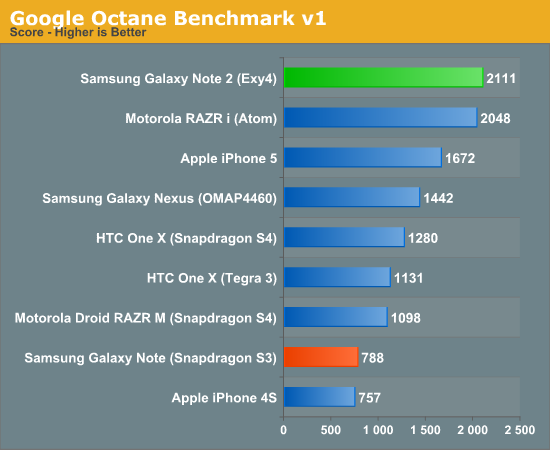
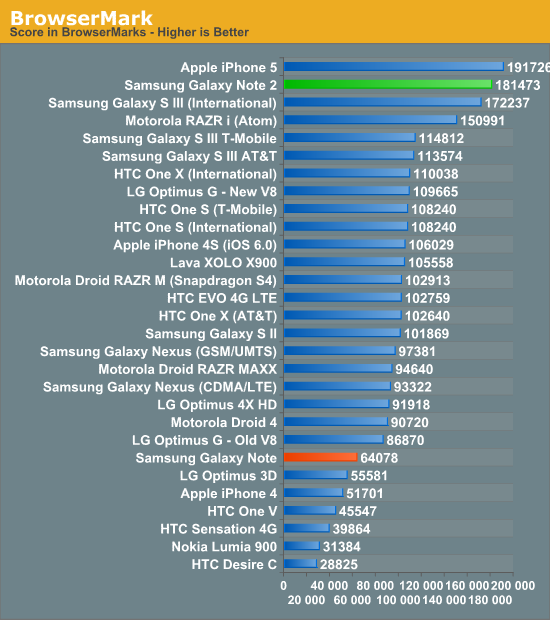
The usual disclosure here is that Android benchmarking is still a non-deterministic beast due to garbage collection, and I’m still not fully satisfied with everything that is available out there, but we have to make do with what we’ve got for the moment.
Next up is GLBenchmark 2.5.1 which now includes a beefier gameplay simulation test called Egypt HD alongside the previous Egypt test which is now named Egypt Classic. Offscreen resolution gets a bump to 1080p as well.
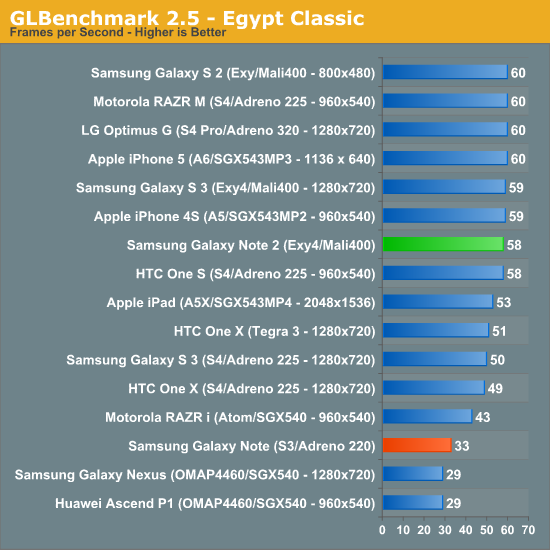
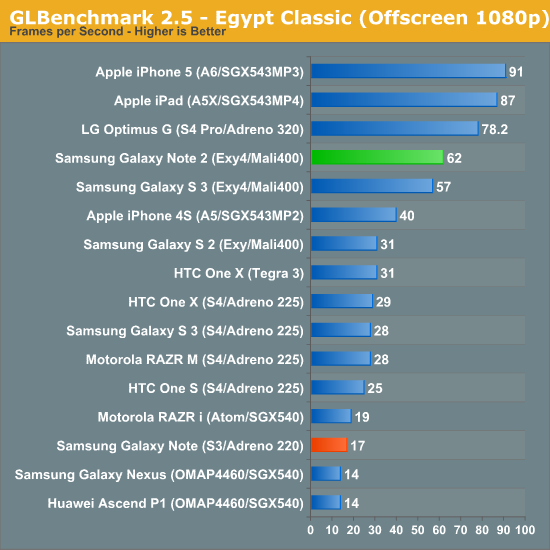
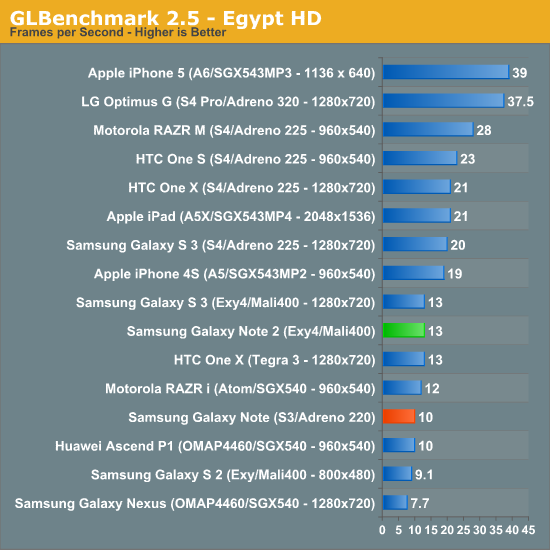
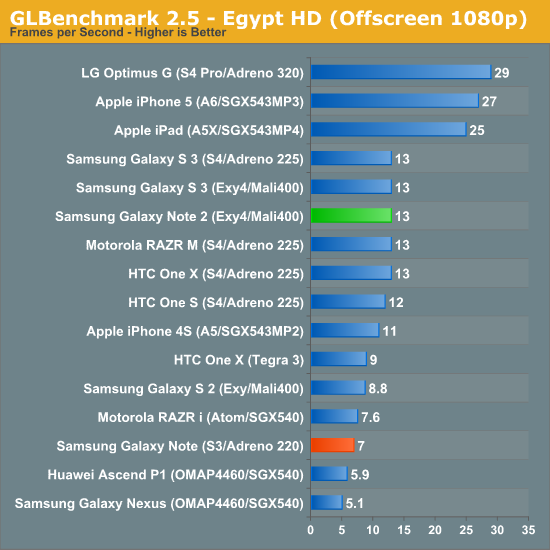
Here we see Mali–400 MP4 performing basically the same as I saw in the International Galaxy S 3 which is no surprise — it is after all the same SoC. Other than a slight bump in the Egypt Classic offscreen performance numbers, there aren’t any surprises. We see Exynos 4412 putting up a good fight, but Adreno 320 in APQ8064 is still something to look out for on the horizon. I'd run Taiji as well but we'd basically just see vsync at this point.
Vellamo 2.0.1 is a new version of the previously well-received Vellamo test developed by Qualcomm initially for in-house performance regression testing and checkin, later adopted by OEMs for their own testing, and finally released onto the Google Play Store. This is the first time the 2.0 version of Vellamo has made an appearance here, and after vetting it and spending time on the phone with its makers I feel just the same way about 2.0 as I did 1.0. There’s still the disclosure that this is Qualcomm’s benchmark, and that stigma will only go away after the app is open sourced for myself and others to code review, but from what deconstruction of the APK I’ve done, and further inspection of the included jS, I’m confident there’s no blatant cheating going on, it isn’t worth it.
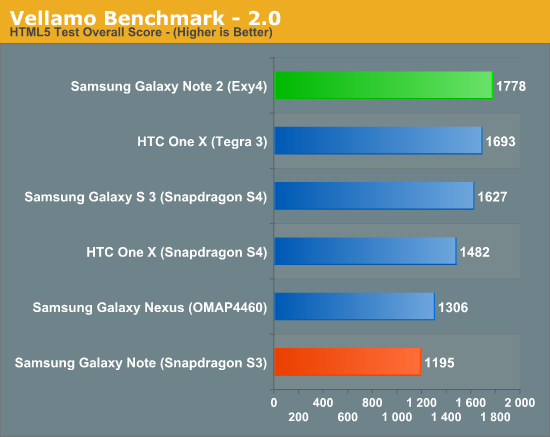
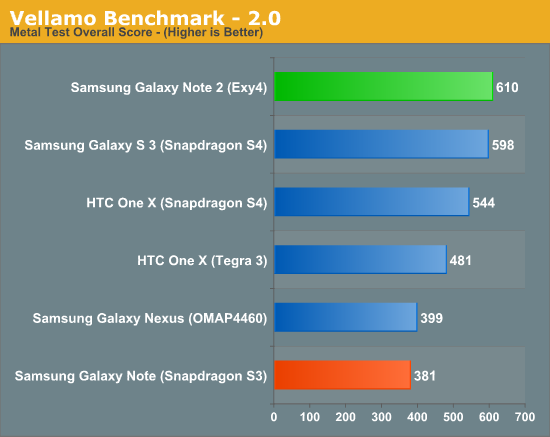
Vellamo 2’s biggest new thing is the inclusion of a new ‘metal’ test which, as the name implies, includes some native tests. This is C code compiled with just the standard android compiler and -o2 optimization flag into both ARMv7 and x86 code. There’s Dhrystone for integer benchmarking, Linpack (native), Branch-K, Stream 5.9, RamJam, and a storage subtest.
Exynos 4412 and Android 4.1 is definitely a potent combination, which puts it close to the top if not at the top in a ton of CPU bound tests. My go-to application with lots of threading is still Chrome for Android, which regularly lights up four core devices completely. Even though our testing is done in the stock browser (since this almost always has the faster, platform-specific V8 library) my subjective tests are in Chrome, and the Note 2 feels very quick.










131 Comments
View All Comments
royalcrown - Friday, November 30, 2012 - link
...says the person with the ugliest avatar...leo jacsion - Tuesday, December 18, 2012 - link
Preservance a professional <a href=" http://preservancetech.com/our-services/web-design... Designing</a> company based in the capital city of India that offers various services for website designing from a static website to CMS driven website to any open source website development to complete e-commerce site to travel portal.dyc4ha - Wednesday, October 24, 2012 - link
Thanks for the great article, I am currently considering an upgrade but didnt include the phablets among my choices because of their size. Now I am willing to go put it back on the table.Old_Fogie_Late_Bloomer - Wednesday, October 24, 2012 - link
Likewise, thanks for the great review, Brian. This phone has been on my upgrade short list and I can't wait to take it for a spin in a store soon. I've tried the Note and the SIII but I definitely need to see how the two meld together, as it were. :-)I wish the numbers for cellular browsing were a little higher, since that's my primary use for a phone and I want to know I can get a full day out of a phone without compromise. I don't know if my Atrix 4G just has really crummy battery life, or if I have unreasonable expectations for smartphones...
I'm also really curious now that you've mentioned the HDR stills...I do enjoy the convenience of taking pictures with a device I always have on me, and just last weekend I really wished I had something with more dynamic range. If the HDR feature works well, that would be another strong mark in it's favor.
Spunjji - Wednesday, October 24, 2012 - link
I've been using a Note 2 in the UK for a couple of weeks now - it routinely lasts for 2 days with all radios and GPS left enabled, a couple of hours worth of browsing, a little gameplay (World of Goo, nothing too stressful), some voice use and a lot of texting. It's currently at 66% after coming off charge at 8am, time now is 10pm. I'm writing this on it now.Point is, it lasts very well! I'm a little surprised by the unexceptional battery life readings in the charts here, but I suspect it's disproportionately affected by the relatively dim screen compared with contemporary phones. 200nits is near maximum on this thing, whereas I rarely go above 50% brightness. Not a flaw with the test so much as an advisory that the battery life will probably get hammered in bright ambient lighting. Similarly, mobile reception in the UK tends to be better. I reckon a full day's heavy use is hardly a stretch though!
Spunjji - Wednesday, October 24, 2012 - link
I've been using a Note 2 in the UK for a couple of weeks now - it routinely lasts for 2 days with all radios and GPS left enabled, a couple of hours worth of browsing, a little gameplay (World of Goo, nothing too stressful), some voice use and a lot of texting. It's currently at 66% after coming off charge at 8am, time now is 10pm. I'm writing this on it now.Point is, it lasts very well! I'm a little surprised by the unexceptional battery life readings in the charts here, but I suspect it's disproportionately affected by the relatively dim screen compared with contemporary phones. 200nits is near maximum on this thing, whereas I rarely go above 50% brightness. Not a flaw with the test so much as an advisory that the battery life will probably get hammered in bright ambient light :)
Spunjji - Wednesday, October 24, 2012 - link
Well, that wasn't supposed to end up there. How odd.Old_Fogie_Late_Bloomer - Wednesday, October 24, 2012 - link
Heh, that's all right. Thanks for the reassurance. :-) I'm pretty sure my Atrix 4G is jacked up; it hardly ever gets to 100% charge and is often at 30% or less by the time I leave work (and it's not like I spend all day dicking around on it).There's a lot that I want to like about this phone and I'm hoping I can snag it at something a bit less than $299 subsidized. I'll have to see what happens when it's finally released. And I'll probably have to wait to check out the Lumia 920, which is smaller(?), claims to have an awesome camera(+?), but has a sealed battery(-!)...
Spunjji - Thursday, October 25, 2012 - link
Yeah, that price is rather extortionate! Again, UK pricing, but I paid £60 up-front plus £36 a month for 24 months. It's the most I've ever paid for a phone and probably ever would pay again, but my old Motorola Defy was having similar troubles to your Atrix so I threw caution to the wind.That Lumia 920 definitely looks worth a shot too - interesting times for mobile phones right now...
RealNinja - Wednesday, October 24, 2012 - link
The Note 2 seems like it takes a...phone just a little too big. The "cup holder" fit criteria puts that into perspective fairly well.What is most interesting (IMO) about this prioduct is finally getting an Exynos product.